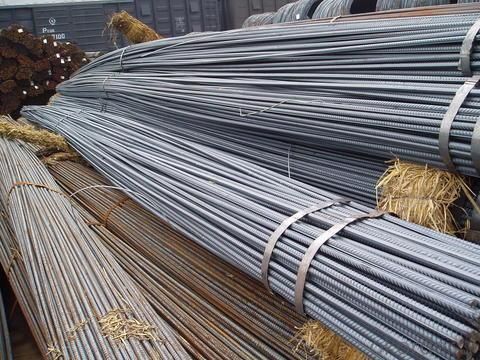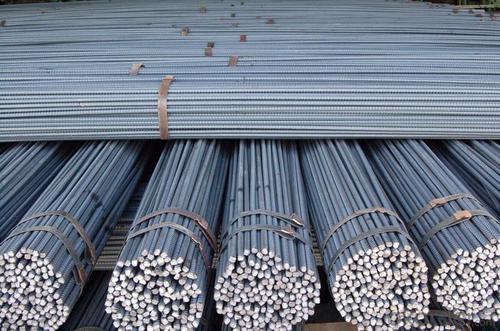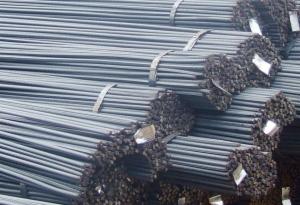High Quality Steel Deformed Bar HRB400 18/20/22mm
- Loading Port:
- Tianjin
- Payment Terms:
- TT or LC
- Min Order Qty:
- 100 m.t
- Supply Capability:
- 10000 m.t/month
OKorder Service Pledge
OKorder Financial Service
You Might Also Like
High Quality Steel Deformed Bar HRB400 18/20/22mm
Product Description:
Specifications of High Quality Steel Deformed Bar HRB400 18/20/22mm:
Standard | GB | HRB400 | |
Diameter | 18mm,20mm, 22mm | ||
Length | 6M, 12M | ||
Place of origin | Hebei, China mainland | ||
Advantages | exact size, regular package, chemical and mechanical properties are stable. | ||
Type | Hot rolled deformed steel bar | ||
Chemical Composition of High Quality Steel Deformed Bar HRB400 18/20/22mm: (Please kindly find our chemistry of our material based on HRB400 as below for your information)
Grade | Technical data of the original chemical composition (%) | ||||||
C | Mn | Si | S | P | V | ||
HRB400 | ≤0.25 | ≤1.60 | ≤0.80 | ≤0.045 | ≤0.045 | 0.04-0.12 | |
Physical capability | |||||||
Yield Strength (N/cm²) | Tensile Strength (N/cm²) | Elongation (%) | |||||
≥400 | ≥570 | ≥14 | |||||
Theoretical weight and section area of High Quality Steel Deformed Bar HRB400 18/20/22mm as below for your information:
Diameter(mm) | Section area (mm²) | Mass(kg/m) | Weight of 12m bar(kg) |
18 | 254.5 | 2.00 | 24 |
20 | 314.2 | 2.47 | 29.64 |
22 | 380.1 | 2.98 | 35.76 |
Usage and Applications of High Quality Steel Deformed Bar HRB400 18/20/22mm:
Deformed bar is widely used in buildings, bridges, roads and other engineering construction. Big to highways, railways, bridges, culverts, tunnels, public facilities such as flood control, dam, small to housing construction, beam, column, wall and the foundation of the plate, deformed bar is an integral structure material. With the development of world economy and the vigorous development of infrastructure construction, real estate, the demand for deformed bar will be larger and larger.
Packaging & Delivery of High Quality Steel Deformed Bar HRB400 18/20/22mm:
Packaging Detail: products are packed in bundle and then shipped by container or bulk vessel, deformed bar is usually naked strapping delivery, when storing, please pay attention to moisture proof. The performance of rust will produce adverse effect.
Each bundle weight: 2-3MT, or as required
Payment term: TT or L/C
Delivery Detail: within 45 days after received advanced payment or LC.
Label: to be specified by customer, generally, each bundle has 1-2 labels
Trade terms: FOB, CFR, CIF
FAQ:
Q1: Why buy Materials & Equipment from OKorder.com?
A1: All products offered byOKorder.com are carefully selected from China's most reliable manufacturing enterprises. Through its ISO certifications, OKorder.com adheres to the highest standards and a commitment to supply chain safety and customer satisfaction.
Q2: How do we guarantee the quality of our products?
A2: We have established an advanced quality management system which conducts strict quality tests at every step, from raw materials to the final product. At the same time, we provide extensive follow-up service assurances as required.
Q3: How soon can we receive the product after purchase?
A3: Within three days of placing an order, we will arrange production. The shipping date is dependent upon the quatity, how many sizes you want and the plan of production, but is typically 1 month to 2 month days from the beginning of production.
Images of High Quality Steel Deformed Bar HRB400 18/20/22mm:


*If you would like to get our price, please inform us the size, standard/material and quantity. Thank you very much for your attention.
- Q: How long do steel rebars last?
- Steel rebars have a lifespan of approximately 50 to 100 years, depending on factors such as environmental conditions, maintenance, and quality of the steel.
- Q: Are steel rebars suitable for reinforcement in parking garages?
- Yes, steel rebars are suitable for reinforcement in parking garages. Steel rebars provide the necessary strength and durability to support the weight of vehicles and withstand the various loads and stresses experienced in parking garage structures.
- Q: Can steel rebars be used in seawater desalination plants?
- Steel rebars are indeed applicable in seawater desalination plants; however, careful consideration must be given to the potential impact of corrosion caused by the high salt concentration in seawater. To address this concern, several measures can be adopted. One popular approach involves employing corrosion-resistant alloys like stainless steel rebars or epoxy-coated rebars to shield against the corrosive effects of saltwater. Furthermore, regular maintenance and monitoring are essential for averting and detecting any corrosion-related problems. In conclusion, although steel rebars can be utilized in seawater desalination plants, it is imperative to incorporate corrosion protection strategies to ensure their durability and structural soundness.
- Q: What are the different grades of steel rebars available?
- The different grades of steel rebars available include Grade 40, Grade 60, Grade 75, and Grade 80, which indicate the minimum yield strength of the rebars in thousands of pounds per square inch (ksi).
- Q: Can steel rebars be used in water treatment plant construction?
- Steel rebars have the capability to be utilized in the construction of water treatment plants. They are frequently employed as a means of reinforcing concrete structures, including those found in water treatment plants. By incorporating these rebars, the concrete structures gain both strength and durability, allowing them to withstand the various stresses and loads they encounter. Additionally, steel rebars possess resistance to corrosion, a crucial characteristic in water treatment plants where exposure to water and chemicals is prevalent. Nevertheless, it is vital to ensure that the rebars employed in the construction of water treatment plants adhere to the required specifications and standards, guaranteeing the structures' longevity and integrity.
- Q: What is the role of steel rebars in preventing structural deformation?
- Various construction projects, including buildings, bridges, and other infrastructure, rely heavily on steel rebars to prevent structural deformation. These rebars, when embedded in concrete, strengthen its ability to withstand tension, as concrete alone is vulnerable to cracking when subjected to tensile stress. The key purpose of steel rebars is to counteract tensile forces that can cause structural deformation. When external loads or forces, such as gravity or wind, are applied to a structure, it experiences both compressive and tensile stresses. While concrete is well-suited to handle compressive forces, it tends to fail under tension and develop cracks. By incorporating steel rebars into the concrete, the overall strength and load-bearing capacity of the structure are significantly enhanced. The rebars serve as tension members, absorbing tensile forces and preventing the concrete from cracking, thus maintaining its integrity. This reinforcement ensures that the forces are distributed more uniformly throughout the structure, minimizing the risk of localized failures or deformations. Moreover, rebars also play a crucial role in controlling and limiting crack propagation caused by factors like shrinkage, temperature fluctuations, or seismic events. These steel bars bridge and hold together any cracks that may occur in the concrete, preventing them from widening and compromising the structure's stability. Steel rebars also contribute to the ductility of the reinforced concrete structure. Ductility refers to a material's ability to deform under stress before reaching its breaking point. The presence of rebars allows the structure to undergo controlled deformation, which is especially important during extreme events like earthquakes or excessive loading. The rebars provide the necessary strength and flexibility to absorb and dissipate energy, thereby reducing the likelihood of catastrophic failure. In conclusion, steel rebars play a crucial role in preventing structural deformation by reinforcing the concrete, enhancing its tensile strength, controlling crack propagation, and improving overall structural integrity. By withstanding tensile forces and enhancing ductility, rebars are essential for ensuring the safety and longevity of various construction projects.
- Q: How do steel rebars contribute to the load-bearing capacity of structures?
- The load-bearing capacity of structures is enhanced by steel rebars in various ways. Firstly, they increase the tensile strength of the concrete, which is weak in tension despite its strength in compression. This addition of steel rebars significantly boosts the structural tensile strength, a crucial aspect considering the different loads structures face, such as dead loads (e.g. the structure's weight), live loads (e.g. occupants, furniture), and environmental loads (e.g. wind, earthquakes). Secondly, steel rebars aid in preventing cracking and improving the overall durability of the structure. Concrete has a tendency to shrink and crack due to factors like temperature changes and moisture. By incorporating steel rebars within the concrete, they act as reinforcement, ensuring a more even distribution of the load and decreasing the likelihood of cracking. This, in turn, enhances the longevity and structural integrity of the building. Moreover, steel rebars also provide support and stability to the structure, particularly against lateral forces that may arise during high winds or seismic events. By securely anchoring the rebars into the foundation or other structural elements, a strong connection is formed, capable of withstanding these lateral loads and safeguarding the structure from collapse or damage. To summarize, steel rebars play a vital role in enhancing the load-bearing capacity of structures through bolstering the tensile strength of the concrete, preventing cracking, and providing stability and support. Their integration into the structural design is paramount for ensuring the safety, durability, and long-term functionality of buildings and other forms of infrastructure.
- Q: Are there any specific safety precautions to be taken while handling steel rebars?
- Yes, there are several safety precautions that should be taken while handling steel rebars. Here are some key points to consider: 1. Personal Protective Equipment (PPE): Always wear appropriate PPE, including safety goggles or glasses, gloves, and steel-toed boots. This will help protect against eye injuries, cuts, and crushed toes. 2. Lifting Techniques: When lifting rebars, use proper lifting techniques such as bending at the knees, keeping the back straight, and using leg muscles to lift the load. Avoid twisting or jerking motions while lifting to prevent strains or sprains. 3. Proper Storage: Store rebars in an organized and secure manner, ensuring they are not leaning against walls or other structures. This will prevent them from falling and causing injuries. 4. Sharp Edges: Be cautious of the sharp edges on rebars. Always handle them with care to avoid cuts or punctures. It is recommended to wear protective gloves to reduce the risk of hand injuries. 5. Secure Transportation: When transporting rebars, secure them properly to prevent movement or falling off the vehicle. Use appropriate restraints such as ropes or straps to secure the load safely. 6. Electrical Hazards: Be aware of any overhead power lines or live electrical sources near the working area. Maintain a safe distance from them to prevent accidental contact with the rebars, which can conduct electricity. 7. Communication and Awareness: Always communicate with other workers in the vicinity to ensure everyone is aware of the presence of rebars. This will help prevent accidental injuries caused by tripping or colliding with the rebars. By following these safety precautions, you can minimize the risk of accidents or injuries while handling steel rebars. It is also important to undergo proper training and adhere to any specific safety guidelines provided by your employer or industry regulations.
- Q: How do steel rebars contribute to the overall stability of a bridge deck?
- Steel rebars contribute to the overall stability of a bridge deck by providing reinforcement and strength to the concrete structure. The rebars are embedded within the concrete, creating a composite material that is able to withstand the loads and stresses imposed on the bridge. This reinforcement helps to prevent cracking, bending, and failure of the bridge deck, ensuring its long-term durability and structural integrity.
- Q: Can steel rebars be used in precast concrete walls?
- Yes, steel rebars can be used in precast concrete walls. In fact, they are commonly used to reinforce the concrete and provide strength and durability to the structure. The rebars are typically placed within the precast panels during the manufacturing process to enhance their load-bearing capacity and resistance to cracking or breaking.
Send your message to us
High Quality Steel Deformed Bar HRB400 18/20/22mm
- Loading Port:
- Tianjin
- Payment Terms:
- TT or LC
- Min Order Qty:
- 100 m.t
- Supply Capability:
- 10000 m.t/month
OKorder Service Pledge
OKorder Financial Service
Similar products
Hot products
Hot Searches
Related keywords




























